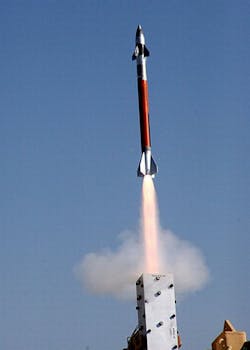Army considers deploying Lockheed Martin missile designed to shoot down rockets and artillery
Officials of the Army Contracting Command at Redstone Arsenal, Ala., announced a potential $46.5 million five-year contract Thursday to the Lockheed Martin Missiles and Fire Control segment in Grand Prairie, Texas, to demonstrate Extended Area Protection and Survivability (EAPS) Integrated Demonstration (ID) technology, and begin moving it to an Army program of record.
Lockheed Martin will demonstrate the EAPS ID technology necessary to counter incoming enemy rocket, artillery, and mortar rounds, as well as enemy cruise missiles and unmanned aerial vehicles (UAVs).
Once demonstrated to the Army's satisfaction, the contract calls for Lockheed Martin to switch EAPS ID technology into the Army's Indirect Fire Protection Capability Increment 2-Intercept (IFPC2-I) program.
The IFPC2-I is a mobile, ground-based weapon system being designed to acquire, track, engage and defeat enemy UAVs, cruise missiles, rockets, artillery shells, and mortar rounds. The System will provide 360-degree protection and will engage threats arriving simultaneously from different directions and altitudes.
IFPC2-I block 1 will have one or more interceptors, fire-control system, a multi-mission launcher, and a Sentinel software upgrade to help the system shoot down UAVs and cruise missiles. IFPC2-I block 2, meanwhile, will develop interceptors, sensors, and fire control to shoot down rockets, artillery shells, and mortar rounds.
The IFPC2-I system will use the Army Integrated Air and Missile Defense (IAMD) Command and Control (C2) open systems architecture, which includes several different sensors that will hand off targeting data from the IAMD to the IFPC2-I system.
Over the past four years Lockheed Martin has been developing an affordable, agile, hit-to-kill interceptor rocket for the EAPS project that is less than three feet long, about two inches in diameter, and weighs less than 10 pounds at launch. Lockheed Martin engineers are aiming at an Army cost target of $16,000 per round.
The Lockheed Martin EAPS interceptor has a high frequency fire control sensor, and a hit-to- kill interceptor that can destroy incoming rockets, artillery, and mortar rounds at tactically significant ranges, company officials say.
Related: Army to buy counter-mortar radars from SRCTec in potential quarter-billion-dollar contract
Three years ago Lockheed Martin flight-tested an EAPS ID rocket at White Sands Missile Range, N.M. During the flight test, the tactically configured miniature hit-to-kill (MHTK) interceptor was launched vertically and then performed a series of maneuvers to demonstrate required performance while capturing data. Additional EAPS ID tests were conducted later in 2012.
Lockheed Martin will build a functional EAPS ID unit called the EAPS Battle Unit to demonstrate the system's ability to shoot down rockets, artillery, and mortar rounds before the incoming munitions can do damage. Following demonstration the interceptors will be folded into the Army's IFPC2-I system.
The Army Contracting Command is awarding the contract to Lockheed Martin on behalf of the Army Aviation and Missile Research, Development and Engineering Center (AMRDEC), Weapons Development, and Integration Directorate (WDID) at Redstone Arsenal, Ala.
For more information contact Lockheed Martin Missiles and Fire Control online at www.lockheedmartin.com/us/mfc, the Army Contracting Command-Redstone at www.acc.army.mil/contractingcenters/acc-rsa, or the Army Aviation and Missile Research, Development and Engineering Center at www.amrdec.army.mil/amrdec.
